Restart
HORSE GENERAL CHECK-UP
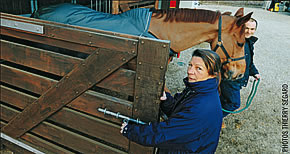
Before making the horse restart training, it is essential to let him have a general check-up at Winter end. Schedule a visit with :
• Vet. The musculature of a horse not regularly working during Winter tends to decrease, especially on the back. « If there is a trouble or a pain on the left, the horse will compensate on the right; he will be tense, will not train correctly and in the long run the pain will tend to increase. » In addition to drawing a balance of the general condition and attracting your attention on specific points to be cared or watched over, the vet will be able to give you suggestions about a training restart planning and feeding adjustment, or to prescribe the vitamin supplements according to the scheduled training.
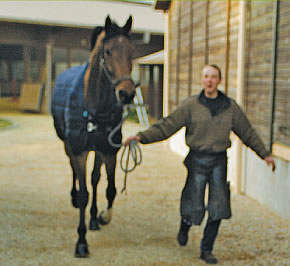
• Dentist. Same precautionary measure in order to detect any anomalies which could interfere with a good food assimilation (as hook), influencing the animal general condition and his behaviour under the saddle (if the contact with the bit or with the noseband hurts).
• Farrier. He will analyse the feet conditions (as soft horn, warm or rotten frog), will prescribe proper care, and adapt the shoeing for a more intensive training. For a ride outside, have horseshoes for studs be applied (in order to be able to hang on if the ground allows it). « If you schedule regular trotting sessions, it would be better to have pad on the front limbs (they will protect the sole on irregular and hard grounds) and tungsten nails (more wear resistant). »
A little general revision of the horse condition is essential after a period of inactivity.
A STEP-BY-STEP TRAINING
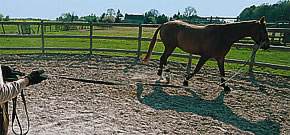
• Lungeing and trotting. These two activities must be combined and alternated. Lungeing for half an hour each day by walking to softly resume physical training, then increase step-by-step up to an hour including some trot beats. The addition of a training system (gogue, chambon) is optional, but recommended to quickly and properly develop the back muscles. There's nothing for the spirit like scheduling regular trotting sessions. The horse, for a long time confined within four walls, will appreciate outing in the open air Don't trust the animal coolness often based on temperature ; make a preliminary relaxing lungeing session in the indoor school before going out if you feel him too quivering. « To develop muscles and breath again, at the beginning go out once or twice per week, each outing lasting half an hour. Mainly walking (be careful with sprains on hard and slippery grounds). The effort should be balanced and risen step by step. »
TRICKS: VERY DELICATE FEET
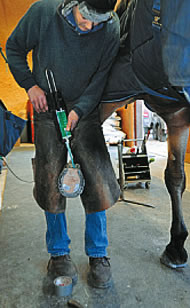
For training resuming and for the first rides outside, Damien Rotkopf (picture), farrier in Seine-et-Marne, suggests the use of shoeing pads on forelimbs. « If the horse had a calm winter in the indoor school, the foot got used to a certain comfort and the resuming of activity on a hard and irregular ground could cause pains. The pads (in leather or rubber) give an additional comfort to the horse, protecting the sole and absorbing the shocks on varied ground. A silicone injection (between pad and sole) increases the protection effect; this damper pad absorbs even more collisions and shocks, and distributes the pressure loads in the foot when bearing full weight. According to foot morphology and required protection, three kinds of silicone can be used. Once dry, pad and silicone are cut in V-shape, in order to free the frog and to be able to treat it if necessary. »
A STEP-BY-STEP TRAINING - CONTINUED
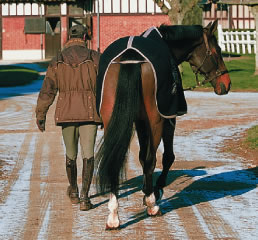
• Outings in hand. Jogging together can be a good solution to stretch out. Daily walking and in-hand outings (at least half an hour) will have an excellent effect on breath and legs conditions before beginning a more challenging work.
The in-hand outings are excellent for both horse and rider.
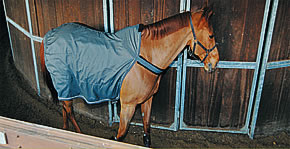
• If there is a horse walker in your riding club. There are several advantages: saving of time (while the horse is training, you can take care of other tasks), the area is safe and defined, it can replace a lungeing training (because of a lack of time); it is an excellent exercise to treat stiffness and aches and smoothly have muscles working. « The best thing is to let the horse slowly restart the training by leaving him daily in the horse walker, increasing the training time day by day. Start with sessions lasting half an hour, walking, in both hands, for some days, then lengthen the training according to the horse behaviour. One walking hour per day, calming and relaxing, is the better way to help your horse to find again his form and muscles. » Take care not to go too fast: check that the horse is not tired, breaths with difficulty or sweats too much under the blanket (to be compulsorily worn if he is clipped). If so, reduce the training duration; if the problem persists, talk about it to the vet. « Once the horse has fully recovered his best condition, you must not be won over by the convenience: the horse walker is a significant help but it will never replace a real training session. »
The horse walker allows to calmly and safely train the horse, and it allows you to attend other tasks during that time.